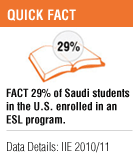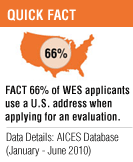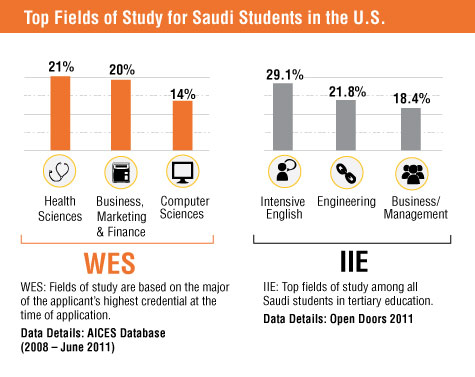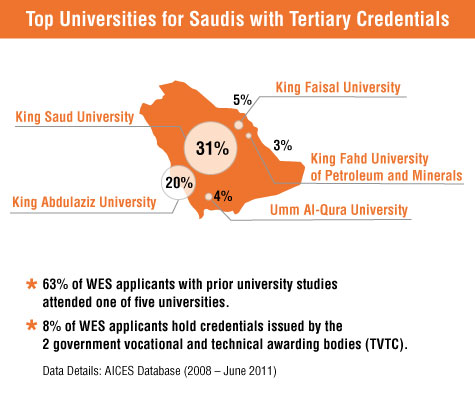WES Data Trends Among Saudi Applicants for Credential Evaluation
Yoko Kono, Research Associate, WES Research and Advisory Services, Nick Clark, Editor, World Education News & Reviews
Since 1989, information specialists at World Education Services (WES) have been using and maintaining a state-of-the-art credential evaluation database known as AICES (Automated International Credential Evaluation System) to help build a powerful source of information on foreign education systems and immigrant trends in the United States.
Based on extensive research on education systems, academic credentials and evaluation methodologies around the world, and an annual credential evaluation volume in excess of 50,000 completed files, this custom-built database currently contains information on over 45,000 academic institutions, nearly 20,000 credentials, and over 1,500 grading scales in 214 different countries and jurisdictions.
While used primarily for in-house credential evaluation and research purposes, AICES is also manipulated by the WES Research and Advisory Services department to deliver trends-based intelligence reports and advisory services for those working in the field of international admissions and recruitment.
As a companion piece to this month’s feature on Obtaining Authentic Secondary Credentials from Saudi Arabia the WES Research and Advisory Services department has compiled a sampling of Saudi applicant trends and intelligence information.
Saudi Application and Enrollment Trends
Data from the last five years of WES evaluations reveal that there has been a large spike in the number of Saudi students coming to the United States for educational purposes. This, of course, is in line with broader national enrollment trends over the same time period, and is thanks in large part to the King Abdullah Scholarship Program.
Total WES credential evaluations for Saudi applicants grew 394% between June 2007 and June 2011, with yearly increase of 59% (08/09), 88% (09/10), and 66% (10/11). The 88% spike in 2009-10 WES applications was mirrored a year later by the surge in overall enrollments shown in the 2010-11 IIE Open Doors data. In academic year 2010-11, enrollments at U.S. institutions of higher education grew 44% versus a three-year average of 26% growth between 2007 and 2010.
Based on growth in WES applicant volume for 2010-11 and growth in the second half (H2) of 2011 versus H2 2010 (66% and 49%) we would predict continued strong growth in overall Saudi enrollments at U.S. institutions of higher education, although at rates closer to the 2007-10 average of 26%.
When reading the WES data, it should be noted that they refer to the volume of credential evaluations ordered and therefore should be read as proxies for student applications rather than enrollments, as a credential evaluations are typically conducted at the beginning of the application process. So, for example, growth or decline in WES evaluations for a particular country in 2011 would serve as an indicator for likely growth or decline in enrollments in academic years 2011/12 and 2012/13. To better approximate the academic year in the graph above, we have combined Half Two (H2) totals with Half One (H1) totals for a series of July through June readings.
 There are a few additional things to keep in mind when looking at WES data. Firstly, two-thirds (66%) of Saudi applicants for WES evaluations have already completed a bachelor degree. While it cannot be assumed that all of those holding bachelor’s degrees will be applying for master’s programs in the United States, there certainly appears to be an imbalance between the intended level of study of Saudi WES applicants and the actual levels of study revealed in the IIE Open Doors data. According to the 2011 Open Doors report, just 20% of Saudi students are studying at the graduate level versus 48% at the undergraduate level, with a further 30% studying English or ‘other.’
There are a few additional things to keep in mind when looking at WES data. Firstly, two-thirds (66%) of Saudi applicants for WES evaluations have already completed a bachelor degree. While it cannot be assumed that all of those holding bachelor’s degrees will be applying for master’s programs in the United States, there certainly appears to be an imbalance between the intended level of study of Saudi WES applicants and the actual levels of study revealed in the IIE Open Doors data. According to the 2011 Open Doors report, just 20% of Saudi students are studying at the graduate level versus 48% at the undergraduate level, with a further 30% studying English or ‘other.’
 This may mean that students already holding Saudi-issued bachelor’s degrees are studying for second undergraduate degrees in the United States in a different field, or that they are applying for ESL programs in the United States before undertaking graduate programs.
This may mean that students already holding Saudi-issued bachelor’s degrees are studying for second undergraduate degrees in the United States in a different field, or that they are applying for ESL programs in the United States before undertaking graduate programs.
The imbalance may also be explained in part by the relative lack of credential fraud with Saudi secondary documentation. U.S. admissions departments may be more comfortable conducting in-house evaluations of high school documents, but be more inclined to outsource the evaluation of undergraduate documents to specialists such as WES.
 A tangential note on ESL programs and WES data relates to the fact that two-thirds of all Saudi applicants applied for WES evaluations using a U.S. mailing address in the years between 2008 and 2010. This would suggest that they are either engaged in U.S.-based ESL programs at the time of application or perhaps that they are using a common U.S. address for application through the King Abdullah Scholarship program.
A tangential note on ESL programs and WES data relates to the fact that two-thirds of all Saudi applicants applied for WES evaluations using a U.S. mailing address in the years between 2008 and 2010. This would suggest that they are either engaged in U.S.-based ESL programs at the time of application or perhaps that they are using a common U.S. address for application through the King Abdullah Scholarship program.
A final thing to keep in mind with regards to WES data is that not all evaluations are conducted for the purposes of education. However, in the Saudi context this is largely a moot point as 98% of all evaluations in 2011 were ordered for educational purposes.
Fields of Study
As WES evaluators see hundreds of different majors when performing Saudi evaluations, the ‘fields of study’ we have grouped disciplines under are very broad generalizations of similar majors. It should also be noted that these are not the fields of study that applicants are necessarily looking to pursue in the United States, rather the fields of study they have a concentration in from previous studies.
Based on the major of the Saudi applicant’s highest credential at the time of evaluation, the top three fields of study that WES saw in the period between January 2008 and June 2011 among Saudi students in the United States were: Health Sciences (21%); Business Marketing & Finance (20%); and Computer Sciences (14%). The Social Sciences (8%), Math & Science (7%), Engineering (6%), and Education (5%) were the next most common fields of study.
Only 3% of the total applicant volume during this period had a highest level of study of secondary schooling or lower. All other applicants had undertaken tertiary studies of one form or another.
According to IIE Open Doors data, the top three fields of study among Saudi students enrolled at a U.S. institution of higher education in 2010/11 were: Intensive English, Engineering, and Business and Management.
Recently cited statistics from the Ministry of Higher show that 70.3% of Saudi students on King Abdullah scholarship students are studying commerce, business administration, engineering, information technology, medical services and medicine in the United States, Britain, Canada, Australia, Egypt and Jordan.
Credentials and Institutions
In calendar year 2010, 60% of the Saudi applications received by WES showed a highest-level credential issued by one of three awarding institutions. At the top of that list is King Saud University, which issued 31% (25% male, 7% female) of the Saudi credentials received by WES evaluated in 2010. The next most frequently received credentials were issued by King Abdulaziz University with 20% of total volume (11% male, 9% female), and those issued by the Technical and Vocational Training Corporation (8% and almost exclusively male) – the government body responsible for regulating and issuing credentials in technical and vocational fields.
After King Saud and King Abdulaziz Universities, the three institutions that WES sees most credentials from, although in significantly smaller numbers, are King Faisal University (5%), Umm Al-Qura University (4%) and King Fahd University of Petroleum and Minerals (3%).
Overall, 63% of Saudi applicants for WES evaluations hold credentials from one of five universities, with a further 8% holding a technical and vocational credential issued by the TVTC.
Demographics
 This brief investigation of Saudi applicant trends reveals a number of demographic generalizations that one can make about Saudi students in the United States.
This brief investigation of Saudi applicant trends reveals a number of demographic generalizations that one can make about Saudi students in the United States.
From the applicant pool of credentials that WES evaluated in 2010, we found that one in six Saudi applicants was male, older than 25 and held a credential from King Saud University. Furthermore, according to our most recent data (2011), males made up 70% of Saudi applicants, but female applicants had grown from 25% of the applicant pool in 2008 to 30% in 2011. The data also show that the 25-28 age group accounted for 50% of applicants in 2011, which was an increase of 8% from 2008.
Conclusion
Not surprisingly, WES has seen considerable growth in credential evaluation applications from Saudi Arabia over the last five years. Given the Saudi government’s ongoing commitment to funding overseas higher education, we expect to see continued growth in Saudi enrollments at U.S. institutions of higher education, especially over the shorter term. This is borne out in WES credential evaluation application volume for the 2011 calendar year, which was up 60% versus 2010 after two years of previously strong growth in 2009 and 2010 (112% and 61% respectively).


